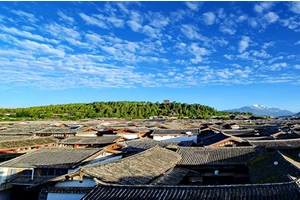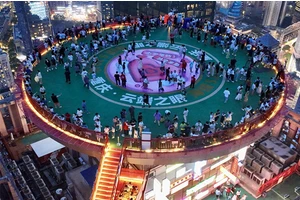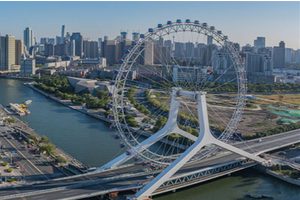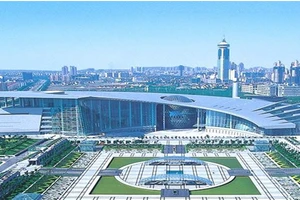Yunnan Red Tourism
The red tourist attractions in Yunnan are recommended as follows.
Zhaotong Weixin County Zhaxi Red Tourism Scenic Spot
Zhaxi Red Scenic Spot in Weixin County, Zhaotong City is an unmissable stop among the red tourist attractions in Yunnan. Relying on the profound red cultural heritage and colorful Miao culture, we should integrate red culture with historical culture and ethnic customs tourism resources.
Lijiang Shigu Ferry Red Tourism Scenic Spot
The red tourist scenic spot of Shigu Ferry was the place where the Red Army crossed the Jinsha River, and it was selected into the List of National Red Tourism Boutique Lines and Red Tourism Classic Scenic Spots published in 2005, mainly to attract tourists with the heroic feelings of "Jinsha River water patting the clouds and cliffs warm". Although Shigu Ferry is located in the same place as the First Bay of the Yangtze River and on the same route as Lijiang City and Laojun Mountain, there are not many tourists because Shigu Ferry is far from the gathering place of scenic spots.
Kuixiang Township, yiliang county City, Yunnan Province
Kuixiang Township, yiliang county, Yunnan, is located at the junction of Yunnan and Guizhou provinces. In 1936, the Second and Sixth Corps of the Chinese Workers and Peasants Red Army led by He Long, Ren Bishi and Xiao Ke went in and out of the township three times during the Long March, sowing the red revolutionary fire. Kui Xiang plans to rebuild the former site of the headquarters of the Red Sixth Army Corps, and build a 3,000-square-meter Wumeng roundabout memorial square around the Red Army Long March Monument, so as to carry forward the spirit of the Long March and highlight the characteristics of the old revolutionary base areas, and the red resort is famous for its martyrs; Build a south, west and north gate respectively, rebuild three gates with the characteristics of the late Qing Dynasty, and reproduce the historical original appearance of "Kuixiang City has four doors and three doors open".
Jinshajiang Jiaopingdu Red Tourism Scenic Spot
Jiaopingdu Red Scenic Spot of Jinshajiang River is located in Jinshajiang River Crossing, which is more than 200 kilometers in Kunming city. Centered on the Red Army Long March Crossing Memorial Hall and Crossing Square, there are Red Army Road and Crossing Road, and tourist shops, hotels and restaurants are built on both sides of the street. In 2004, Jiaopingdu was listed as one of the 30 national red tourist boutique lines and 100 red scenic spots, and the number of sightseeing teams visiting Jiaopingdu was increasing.
I hope my answer is right for you. Good luck!
When you mention Yunnan, the first thing you think of is not the spectacular and beautiful natural landscape, but the colorful ethnic customs. As we all know, Yunnan also has a profound revolutionary tradition. The following are 10 red tourist attractions in Yunnan. Friends who are interested in red tourism, if you want to remember the revolutionary martyrs, then these 10 places must not be missed!
I. Prestige: Tashi Red Tourist Resort
Zhaotong (formerly known as Zhaxi) is a must-see stop among the red tourist attractions. In February 1935, Mao Zedong, Zhou Enlai, Zhu De, Liu Shaoqi, Chen Yun, Zhang Wentian and other proletarian revolutionaries of the older generation led the CPC Central Committee and the Central Red Army, held a world-renowned Tashi meeting in prestige, and reorganized Tashi. As the turning point of life and death, China's victorious revolution, prestige has too many beautiful memories in the revolutionary history. This place where the revolutionary fire was sown left the footprints and stories of the Red Army. Rich in red culture, it is a tourist attraction to enjoy the feast of red cultural spirit and receive revolutionary traditional education.
Two. Huize: the former site of the expansion of Shuicheng Red Army.
The military development zone of Huize Shuicheng, the former site of the Red Army, belongs to the national red tourism classic scenic spot. It is located in the suburb of Huize County, Qujing City, accessible from Kunming along the Song Zhao Expressway, 208 kilometers away from Kunming City and 183 kilometers away from Qujing City.
In 1935, the Ninth Army of the First Army of the Chinese Workers' and Peasants' Red Army passed through here on the Long March, expanding its troops by more than 1,300 people at one time and raising 100,000 silver dollars, which provided a guarantee for the Central Red Army to reach northern Shaanxi smoothly. The military expansion of the United States, the former site of Shuicheng, has also gone down in history.
Iii. Lijiang: a red tourist attraction at Shigu Ferry.
In April 1936, the Second Army of the Chinese Workers and Peasants Red Army, led by He Long, Ren and Xiao Ke, crossed the river from here to fight against Japan. After liberation, the Red Army Long March Ferry Monument, which is 8.1 meters high, was built on the high slope behind the Shigu Monument in Lijiang. It stands on a steep high slope, majestic and solemn, overlooking the first bay, which can make you feel pious. It is a key cultural relic protection unit in Yunnan Province. The archway in front of the monument is the Red Army Crossing the River Memorial Room. The relic of the Red Army, the Long March, shows this great army more vividly in the showroom more than half a century ago.
Yuanmou Long Street: the Red Tourist Attraction of Jinsha River Ferry
Longjie Ferry is not only the main ferry crossing between Sichuan and Yunnan businessmen along the Yangtze River for hundreds of miles, but also a battleground for military strategists. Zhuge Liang captured Meng Huo seven times when crossing the river in Shuhan.
In May 1935, the Red Army set up a pontoon bridge here to cross the Jinsha River and wrote seven slogans of the Red Army. In the war of liberation, the PLA crossed the river in a wooden boat for seven days to suppress bandits. The ancient Longchuan Street is the main crossing of the commercial avenue in Sichuan and Yunnan provinces and the Southern Silk Road. For thousands of years, businessmen from Sichuan and Yunnan have been coming and going here. Longchuan Street is still a battleground for military strategists since ancient times.
5. Diqing: Central Town Court of Shangri-La County
On April 29th, 1936, the Red Second Front Army led by He Long passed Zhongdian (now Shangri-La) and took Shangri-La Central Town as its headquarters. In late May 1936, the Red Second Army Corps left the north of the city, and then the Red Sixth Army Corps led by Xiao Ke and Wang Zhen conducted another 14 days of court training and held a meeting of political cadres. The rest of the Second and Sixth Army Corps in the courtyard of Shangri-La Central Town is the longest rest since Sangzhi and Liu Jiaping set off for the Long March. Today, the town hall of Shangri-La Center, as the memorial hall of the Red Army, reproduces the unforgettable scene of the Red Army and the Long March passes through Zhongdian (now Shangri-La).
6. Xundian: Kedu Red Army Long March Memorial Hall
Located in Dangui Village, Kedu Town, Xundian Hui and Yi Autonomous County in the north of Kunming, on April 28th, 1935, the Central Red Army marched into Xundian County, and on April 30th, the column of the Military Commission entered Kedu Bazi. Mao Zedong, Zhou Enlai, Zhu De, Zhang Wentian, Wang Jiaxiang and other central leaders all stayed in Kedu Dangui Village on the evening of July 18th to make specific arrangements for crossing the river. On April 4th, 1936, the Red 26th Army, led by He Long, Ren and others, entered Xundian County, where it hit the Yunnan Army hard and crushed the enemy. This was a frightening plot. In commemoration of the Great Long March of the Red Army, Yunnan Province established the Long March of Dangui Village in Kedu Town, Kedu Memorial Hall of the Red Army. In 2005, Kedu Red Army Long March Memorial Hall was awarded as one of the 100 classic scenic spots of red tourism in China.
7. Luquan: Jiaopingdu Red Scenic Spot in Jinsha River.
Jiaoping Ferry is located in Jiaoping Village, Jiaoxi Town, Luquan Yi and Miao Autonomous County, more than 200 kilometers away from Kunming, 47 kilometers southeast of Huili County, with mountains on both sides. It is one of the main ferries between Yunnan and Sichuan. From May 1 to 9, 1935, after nine days and nine nights of hard work by 36 boatmen and six ships in Jiaopingdu, 30,000 Red Army successfully got rid of the siege of hundreds of thousands of Kuomintang troops and really jumped out of the enemy's encirclement. Since then, Jiao Pingdu has been written into the glorious history of China Revolution. In 1992, Yunnan Province built the Red Army Crossing the River Monument and the Red Army Crossing the River Memorial Hall in Jiaopingdu.
Eight, Tengchong Heshun: Ai Siqi's former residence
Feel the thoughts and breath left by great philosophers in the ancient house surrounded by green trees. Ai Siqi s former residence is located in Shuidui Village, Heshun Township. It is a quadrangle with brick-catalpa wood structure and a combination of Chinese and western styles. There are a series of stairs and railings, carved lattice fans and western-style small balconies, which are simple and elegant. Ai Siqi Memorial Hall hangs at the gate, and Ai Siqi's life stories are displayed in the West Building and Auditorium Building. Ai Siqi, formerly known as Li Shengxuan, was born in Shunshuidui Village, Tengchong in February 1910. His father, Li Yue, was a veteran of the Revolution of 1911 and followed Sun Yat-sen's revolution. He has served as the director and deputy director of the Philosophy Teaching and Research Section of the Central Committee of the Communist Party of China Senior Party School, the vice president of China Philosophy Society, and the member of the Department of Philosophy and Social Sciences of China Academy of Sciences. After his death, Chairman Mao wrote an inscription for the loyal soldiers on the theoretical front of the Party in his eulogy.
Nine. Kunming: Yunnan Military Academy
Located in the center of Kunming, on the west side of Cuihu Park, it is a famous military academy in modern China. When it was founded, it was called the three martial arts schools together with Tianjin and Fengtian Martial Arts Schools. Later, it was the same as Huangpu Military Academy and Baoding Army Military Academy. During the school period, a large number of outstanding military strategists and revolutionaries were trained, including Zhu De and Ye Jianying, the founding marshals of the Republic. In the Yunnan Uprising of 1911 and the movement to defend the country, Yunnan Military Academy was an important stronghold to cultivate revolutionary forces and the core to unite them. Because of this, Zhu De, a former student of Yunnan Military Academy, called Yunnan Military Academy a revolutionary melting pot. In 1988, the former site of Yunnan Military Academy was announced by the State Council as a national key cultural relic protection unit.
X. Kunming: Tomb of the Fourth Martyr December 1st
It is located in the former site of National Southwest Associated University in Kunming, Yunnan Province and in the campus of Yunnan Normal University today. It was built in memory of the four martyrs who died in the December 11th Movement. There are two stone pillars in front of the tomb, with bright red torches at the top; The pedestal is engraved with Wen Yiduo's "The Story of the 121 Movement", and the stone screen behind the tomb is the relief of the god of freedom: countless young people follow the Statue of Liberty, running for freedom and calling for light. Under the relief, there are sentimental mourning poems engraved. There is a chain fence tomb around the martyr, and the whole cemetery is solemn. Every year, thousands of people come here to pay homage. Teenagers often come here to visit graves to mourn.






